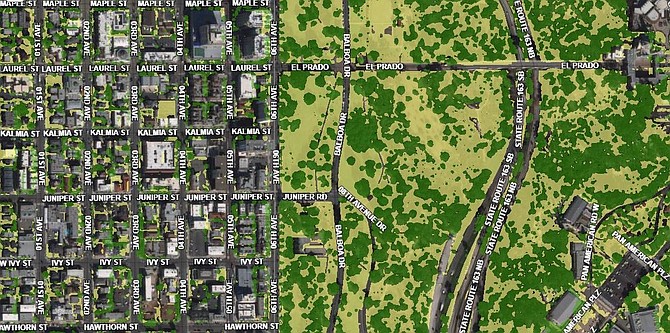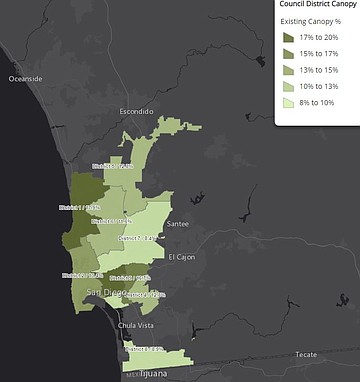 Facebook
Facebook
 X
X
 Instagram
Instagram
 TikTok
TikTok
 Youtube
Youtube

San Diegans want more trees. That was made clear in surveys for the climate action plan update, but tree advocates say the urban canopy is stuck in time.
Under the 2015 climate action plan, a goal of 15 percent coverage by 2020 fell short; today trees cover 13 percent of the city.
Amid losses to development, pests, and disease, the city has removed as many trees as it planted in the past two years, according to Anne Fege, chair of the community forest advisory board.
That's where private property owners come in. The city's website notes that an urban forest "is an entire ecosystem that includes trees on both public and private property."
Advocates say homes and businesses offer ground to expand the urban canopy, and owners are likely to care for the trees, while the city's budget for street tree maintenance languishes.
Tree fans worry it will be a missed opportunity. In many new developments, including those with backyard granny flats, mature shade trees are being removed and not replaced. San Diego lacks a policy to mitigate their loss.

"We need to be honest about tree losses during urban infill projects, as large trees are often removed and narrow setbacks leave little or no room for trees," Fege commented.
Permits for development on private land are approved by the development services department, which oversees permitting for both planting and removal of trees under the city’s jurisdiction.
Noting that San Diego is caught between a housing crisis and a climate emergency, City Councilmember Sean Elo-Rivera has called for changes to the granny flat ordinance, approved in October 2020, and trees are part of it.
The ordinance is meant to comply with state law and encourage property owners to build more granny flats to house more renters. And they are. The number of units permitted for construction rose from 32 in 2017 to 627 in 2019.
In 2020, 493 of these backyard units were permitted, according to the City of San Diego's Annual Housing Inventory Report.
The city's ordinance has a meager landscaping requirement for new companion units, to be planted in the front yard or abutting parkway: one 24-inch box tree.
"It is important that we mitigate the loss of mature shade trees" removed to make way for a granny flat, Elo-Rivera said.
"I propose that any development of [a granny flat] that removes a mature shade tree is required to replace each tree," within the parkway next to the property or the community planning area where it's built.
During public comment on the climate action plan update, others accused developers of swooping in and taking advantage of the accessory dwelling unit ordinance - to the detriment of the urban canopy.
It's happening right now at properties in Talmadge and soon, in Clairemont, said Paul Krueger, asking that the city "amend its regulations that allow developers to clear cut existing lots and not replace a single tree."


San Diegans want more trees. That was made clear in surveys for the climate action plan update, but tree advocates say the urban canopy is stuck in time.
Under the 2015 climate action plan, a goal of 15 percent coverage by 2020 fell short; today trees cover 13 percent of the city.
Amid losses to development, pests, and disease, the city has removed as many trees as it planted in the past two years, according to Anne Fege, chair of the community forest advisory board.
That's where private property owners come in. The city's website notes that an urban forest "is an entire ecosystem that includes trees on both public and private property."
Advocates say homes and businesses offer ground to expand the urban canopy, and owners are likely to care for the trees, while the city's budget for street tree maintenance languishes.
Tree fans worry it will be a missed opportunity. In many new developments, including those with backyard granny flats, mature shade trees are being removed and not replaced. San Diego lacks a policy to mitigate their loss.

"We need to be honest about tree losses during urban infill projects, as large trees are often removed and narrow setbacks leave little or no room for trees," Fege commented.
Permits for development on private land are approved by the development services department, which oversees permitting for both planting and removal of trees under the city’s jurisdiction.
Noting that San Diego is caught between a housing crisis and a climate emergency, City Councilmember Sean Elo-Rivera has called for changes to the granny flat ordinance, approved in October 2020, and trees are part of it.
The ordinance is meant to comply with state law and encourage property owners to build more granny flats to house more renters. And they are. The number of units permitted for construction rose from 32 in 2017 to 627 in 2019.
In 2020, 493 of these backyard units were permitted, according to the City of San Diego's Annual Housing Inventory Report.
The city's ordinance has a meager landscaping requirement for new companion units, to be planted in the front yard or abutting parkway: one 24-inch box tree.
"It is important that we mitigate the loss of mature shade trees" removed to make way for a granny flat, Elo-Rivera said.
"I propose that any development of [a granny flat] that removes a mature shade tree is required to replace each tree," within the parkway next to the property or the community planning area where it's built.
During public comment on the climate action plan update, others accused developers of swooping in and taking advantage of the accessory dwelling unit ordinance - to the detriment of the urban canopy.
It's happening right now at properties in Talmadge and soon, in Clairemont, said Paul Krueger, asking that the city "amend its regulations that allow developers to clear cut existing lots and not replace a single tree."
Comments